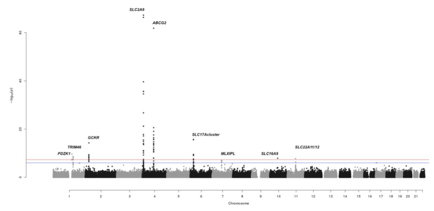Session Information
Session Type: ACR Poster Session B
Session Time: 9:00AM-11:00AM
A genome-wide association study of gout in people of European ancestry
Background/Purpose: Genome wide association studies (GWAS) have provided considerable insight into the molecular control of urate levels. However, less is known about the progression from asymptomatic hyperuricemia to gout. Our aim was to conduct a GWAS for gout in people of European ancestry using the largest number of cases of gout to date.
Methods: This GWAS (7,431 cases and 105,631 controls) was comprised of three data sets: a mixed New Zealand (NZ), Eurogout, and Ardea Biosciences group (3,961 cases; 1,547 controls; genotyped using the Illumina CoreExome v24 array, 547,644 markers), a composite set from the Health Professionals Follow-Up (HPFS) and NursesÕ Health Studies (NHS) (1,038 cases; 1,095 controls; genotyped using the Illumina OmniExpress v12 array, 730,525 markers), and UK Biobank (2,432 cases; 102,989 controls; genotyped using an Affymetrix Axiom array, 820,967 markers). The UK Biobank genotypes were imputed to ~73.3M SNPs. Neither the NZ/Eurogout/Ardea nor NHS/HPFS genotype sets were imputed. Markers found within all three data sets (234,062) were identified and associated with gout (adjusted for sex and age), within each data set separately, using PLINK v1.9. An inverse-variance weighted meta-analysis of the results was then performed using the meta v4.4 package within R v3.2.3. The overall genome inflation factor was 0.90.
Results: There were nine loci with experiment-wide significance (0.05/234,062; P < 2×10-7) for association with gout: ABCG2 (OR=1.77), SLC2A9 (OR=1.69), GCKR (OR=1.24), MLXIPL (OR=1.18), SLC17A1-A4 (OR=1.22), SLC16A9 (OR=1.18), SLC22A12 (OR=1.16), PDZK1 (OR=1.16), TRIM46 (OR=1.15). All nine of these loci have been previously associated with serum urate levels in genome-wide studies with the urate-increasing alleles also associated with increased risk of gout in this study.
Conclusion: Our data emphasize the central importance of genetic involvement in serum urate levels, compared to the genetic involvement in MSU crystal formation, or the innate immune response, in determining gout.
To cite this abstract in AMA style:
Merriman TR, Cadzow M, Merriman ME, Phipps-Green A, Topless R, Abhishek A, Andrés M, Bradbury LA, Buchanan R, Cremin K, Guzman ED, de Zoysa J, Doherty M, Hill C, Huizinga TWJ, Jansen T, Janssen M, Joosten LAB, Kurreeman F, Lester S, Liote F, Macartney-Coxson D, Matsuo H, McCarthy GM, McCormick S, Murphy R, Pavelka K, Perez-Ruiz F, Puig J, Radstake TR, Riches P, Rischmueller M, Roddy E, Smith M, Stahl EA, Stiburkova B, Stubbs R, Tausche AK, Torres R, Walker R, Yamamoto K, Brown MA, Choi HK, Dalbeth N, Miner JN, So A, Stamp LK, Major T. A Genome-Wide Association Study of Gout in People of European Ancestry [abstract]. Arthritis Rheumatol. 2017; 69 (suppl 10). https://acrabstracts.org/abstract/a-genome-wide-association-study-of-gout-in-people-of-european-ancestry/. Accessed .« Back to 2017 ACR/ARHP Annual Meeting
ACR Meeting Abstracts - https://acrabstracts.org/abstract/a-genome-wide-association-study-of-gout-in-people-of-european-ancestry/

